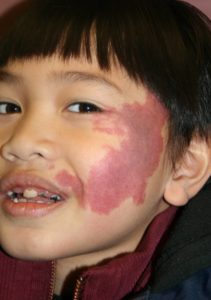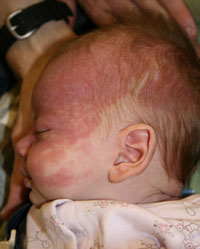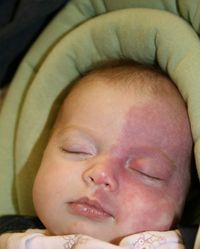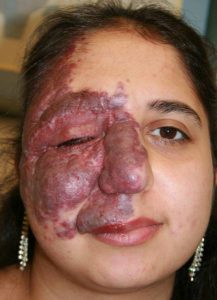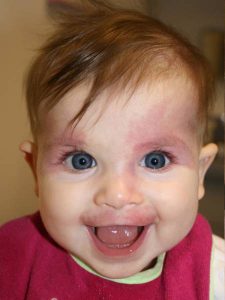We have compiled as many before and after photos of our patients to show some of the results that we have achieved. Some of the patients are still having treatments and their photos will be updated after future procedures. Every case is different, but we hope that it helps to see photos that might be representative of what your child is experiencing.
Laser
Port wine stains were amongst the first lesions to be successfully treated by lasers. The standard of care at this point in time involves the use of a Pulsed Dye Laser. Almost all lasers these days have some sort of cooling device. Once again, an experienced physician is always desirable. The rate of complications is extremely low and in the vast majority of cases, the portwine stain should lighten significantly with treatment. Only a small percentage of portwine stains will disappear with treatment (10-12 %). There are a few important principles. Geographic, nonconfluent portwine stains do much better than confluent portwine stains.This does not mean that confluent portwine stains will not do well. Early treatment is advantageous. The younger the child the more efficacious the treatment. The very first treatment seems to be the most important, especially when dealing with a young child. Some areas appear to do much better than others. Central facial lesions do well. Forehead and eyelid lesions also do well, as do temple lesions. Central cheek portwine stains fare worst of all facial portwine stains. Shoulder and upper chest lesions do well. Upper arm lesions do better than the lower part of the arm. Hand and feet lesions do worst of all.
It will usually take between 6 and 10 treatments to get maximum lightening. The timing of the interval between treatments is arbitrary. We usually space treatments 6 – 8 weeks apart during the first few treatments but, as the treatment advances, the interval between treatments increases to 3 months and eventually 6 months.
One of the controversies concerns the recurrence of portwine stains after treatments. Since laser treatment is aimed at the effect and not the cause of portwine stains, it stands to reason that the lesion will eventually return. All this means is that the patient will need a ‘maintenance’ treatment every few years in order to keep the desired effect.

